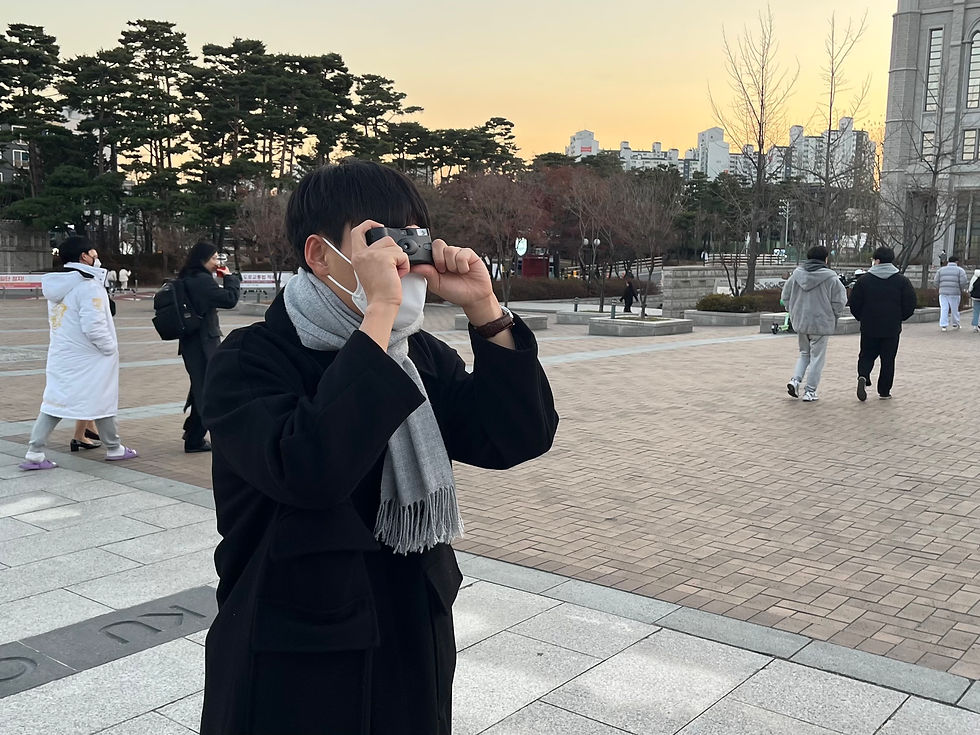Sky-rocketing price in camera films amid retro trends among MZ generation
- 창완유[ 학부재학 / 미디어학부 ]
- Dec 16, 2022
- 4 min read
December 11, 2022
Sanghyup Kim, Tingyu Lin
Despite living in the era of smartphones and social media, many young Koreans have gained interest in taking photos with vintage filtered camera films that provoke a sense of nostalgia.
Park Giwon, a sophomore at Kyonggi University, revealed that his reminiscence and curiosity made him start using his disposable camera. “Glitch effects and irregular screen proportions in retro styled film photos give us more eccentric and quirky vibes compared to those taken from our normal smartphones,” Park explained.

Park taking a photo with his disposable camera in his first visit to Korea University
In spite of the immense popularity, the production line of film companies could not keep up with the exponential growth in demand for films. According to Oh Seung-Hoon, the manager of Kodak Express, the supply of Kodak films have decreased between 70 to 80% in the global market, largely due to the availability of new technologies and COVID-19 pandemic, forcing factories to shut down. However, the continuous rise in demand for films caused the prices to further increase by 20% from last year.
Oh also added “Our head office in the US prioritizes films to be sold in the domestic market before importing the rest to Europe and then Asia,” highlighting the reason why the prices in South Korea are more expensive than the ones in the US and Europe.
South Korea used to possess domestic film companies 20 years ago, when a number of Korean conglomerate firms, such as Doosan, owned film factories. However, due to the release of digital cameras in the early 2000s and the launch of smartphones in the 2010s, Korean film manufacturers started to close down. Subsequently, there are no film producers based in South Korea, resulting in a complete reliance on film imports. Thus, the lack of domestic firms have created a snowball effect in the surge of film prices.

Oh busily working at his Kodak Express office

Kodak film cameras on display for sale
As camera films are making a comeback in terms of popularity, many are questioning the reason why Korean companies are not re-joining the film business as well as major film companies, such as Kodak and Fuji, not reinvesting in expanding film production lines. Park Jin-Woo, professor at the Hankuk University of Foreign Studies Business School, observed some of the uncertainties firms may have had in mass-producing films again.
“Due to the unstable nature of how trends resurface and disappear, especially among MZ generations that are known to quickly change in preference, companies seem to be reluctant to raise production,” Park presumed. He also underlined that film companies still have traumas from almost facing bankruptcy in the past, when the demand for films plummeted due to people’s preference of new technologies then.

Kodak was one of the many film companies that were affected by the fall in demand of films
The escalation in prices have also impacted film labs as the excessive demand precipitated incessant shortage of films. Lee Jin-Hyuk, the owner of 135/36 (Il-Sam-O-Sam-Yook) film lab in Chungmuro, stated that he suffers an issue of film scarcity as customers often find themselves having to leave without buying the film they want.

A note informing shortage of films to customers in front of an empty shelf

A young customer browsing through displayed photo collections and film cameras
Lee also mentioned how the increase in film prices changed the perception of film cameras in the society. “As the film prices have sky-rocketed, I have heard an interesting phrase which was ‘taking pictures with film cameras is now an expensive hobby.’ I believe this phrase is symbolic that describes the current inflation.”

Two young customers posing for a selfie with their developed film photos
What used to be an activity that wasn’t so burdensome all of a sudden became a symbol of comparative wealth and leeway among the MZ generation. Hence, Lee conveyed his concern of what the future may uphold with his film lab, however, just like every other trend, he sees retro to come and go, non-stop.
“The difference is that while the restoration process of such a trend remains, the way we express via various media will change, depending on what is affordable at the time,” responded Lee to whether the proliferating prices of films will cause the retro trend to completely die out.

Film related goods that played up to the high prices of films along with the retro trend
With the prices of films not looking to go down anytime soon, young camera enthusiasts are looking for alternative ways to acquire their products. Many visit the Dongmyo Flea Market, where prices are relatively lower than the ones in the camera stores. Cheaper prices, however, makes it almost impossible for them to purchase films, as the demands are even higher. Therefore, some young customers even choose to buy expired film rolls or multiple disposable cameras at once, due to the difficulty of obtaining new films.

Young customers looking at vintage cameras in Dongmyo, one of the largest flea markets in South Korea

Stacks of vintage film and digital cameras being sold in Dongmyo Flea Market
The increase in prices of films are leaving the MZ generation to seek for a different approach in buying films as the retro trend does not look like it is going to dissipate just yet. Nevertheless, if the price inflation does not slow down, there could be fears of the retro trend dying off once again.



Comments